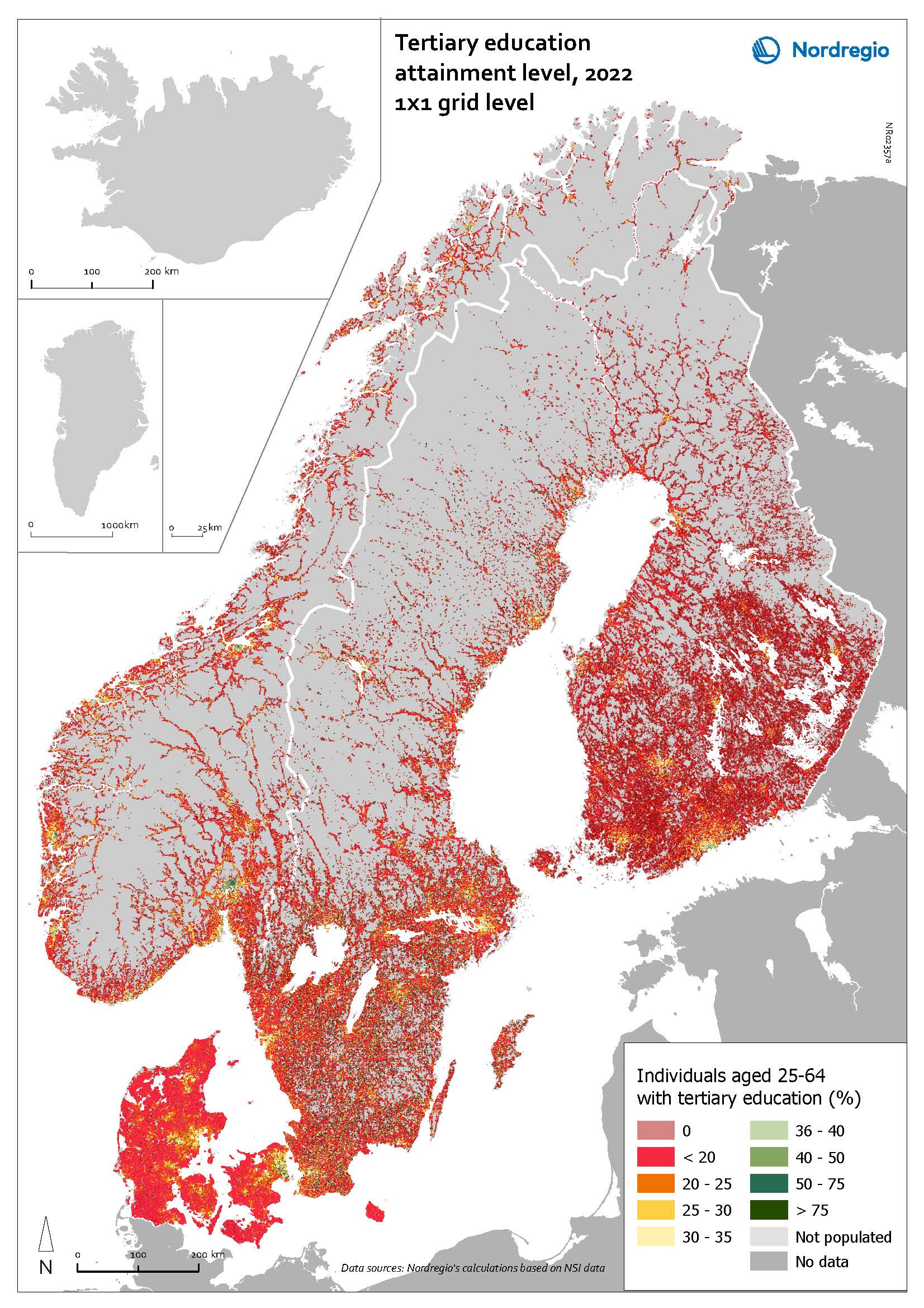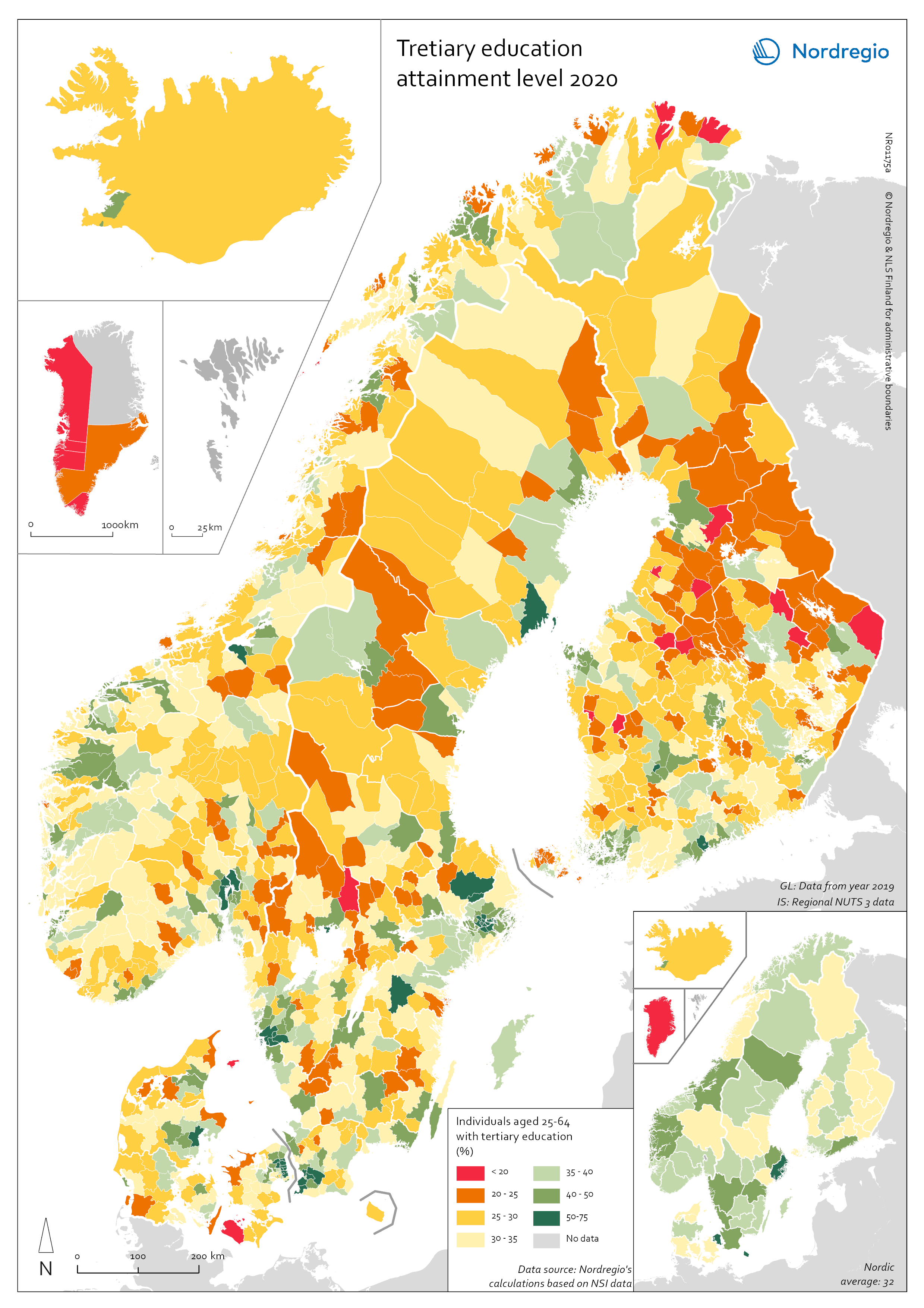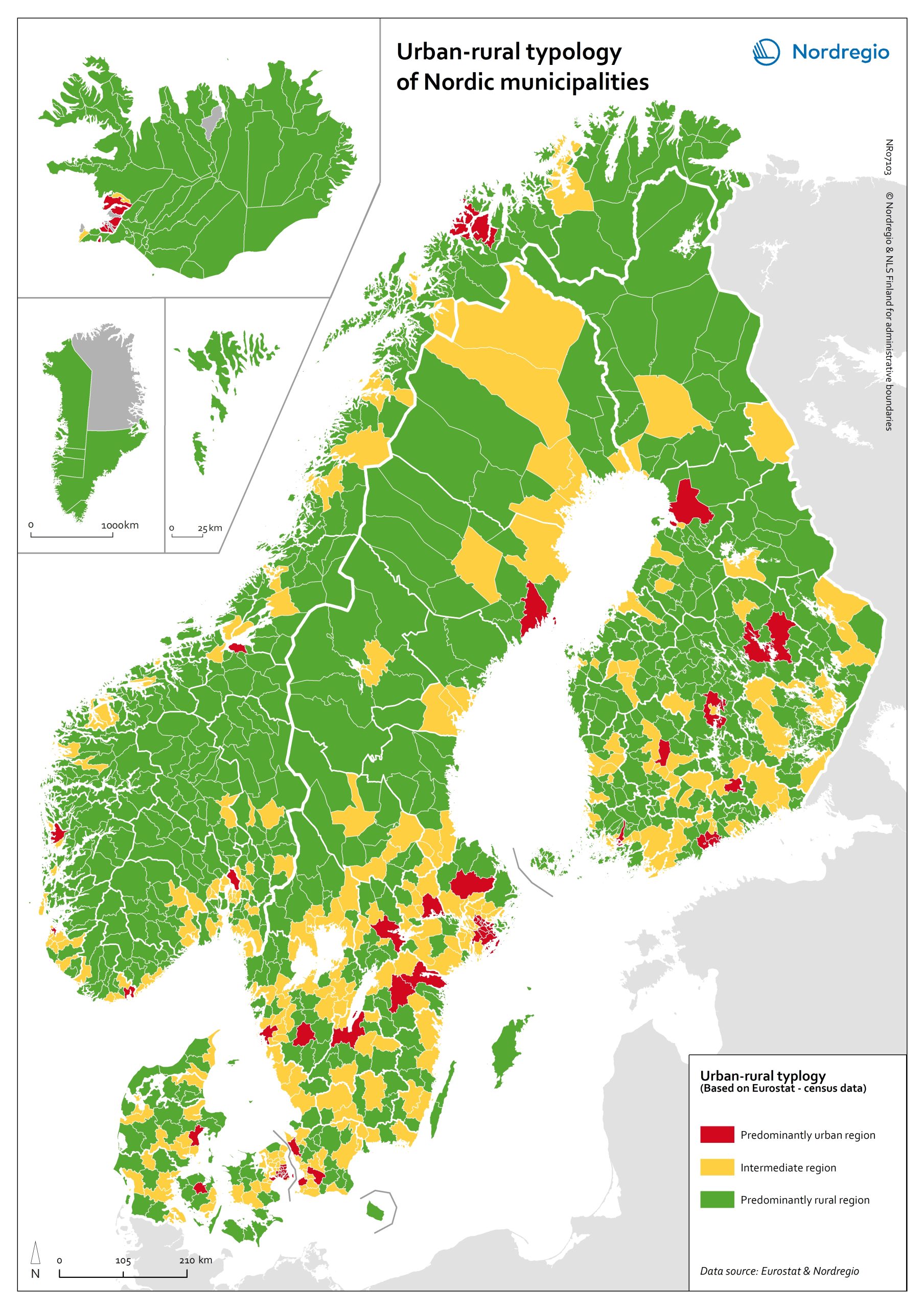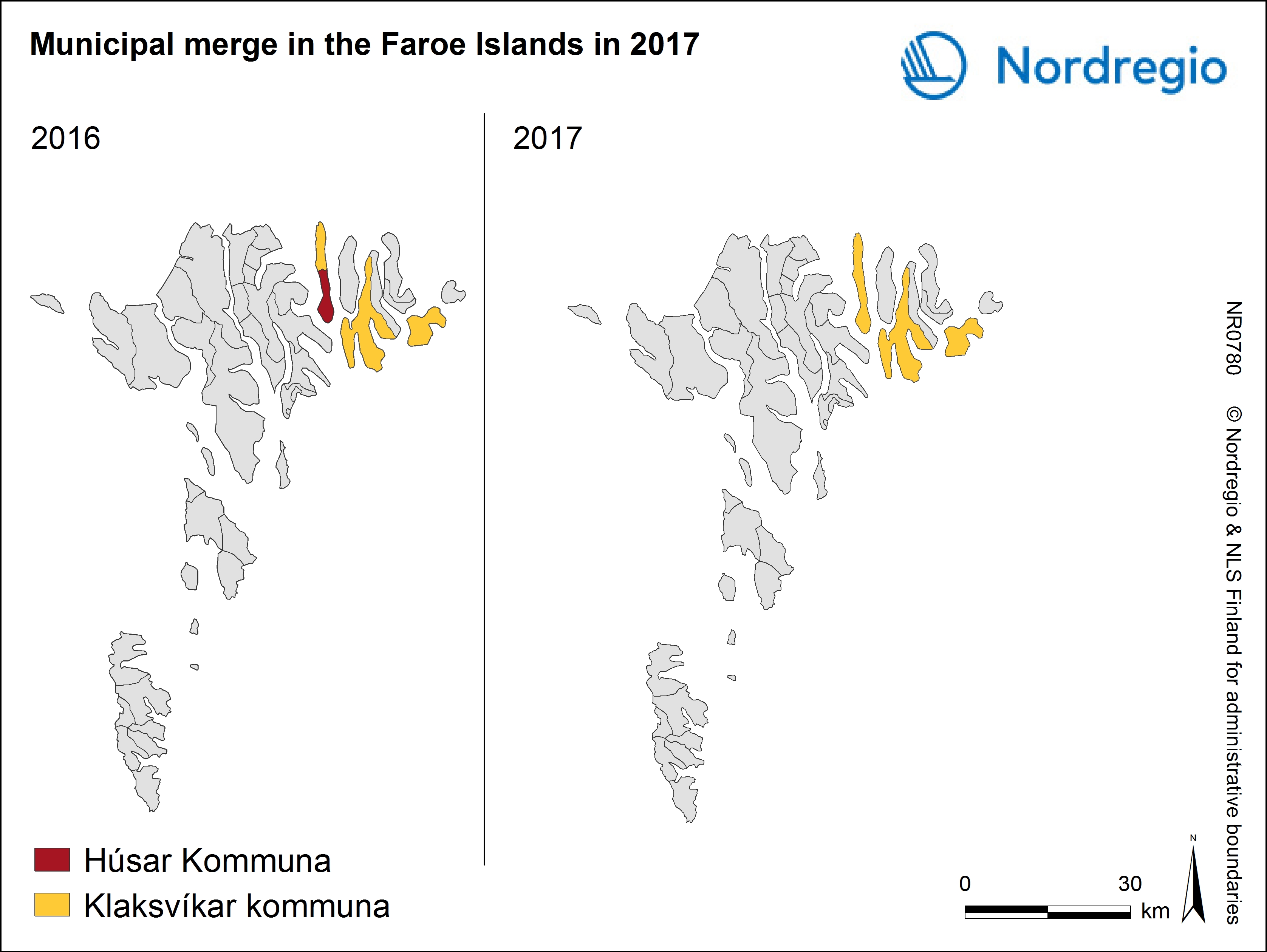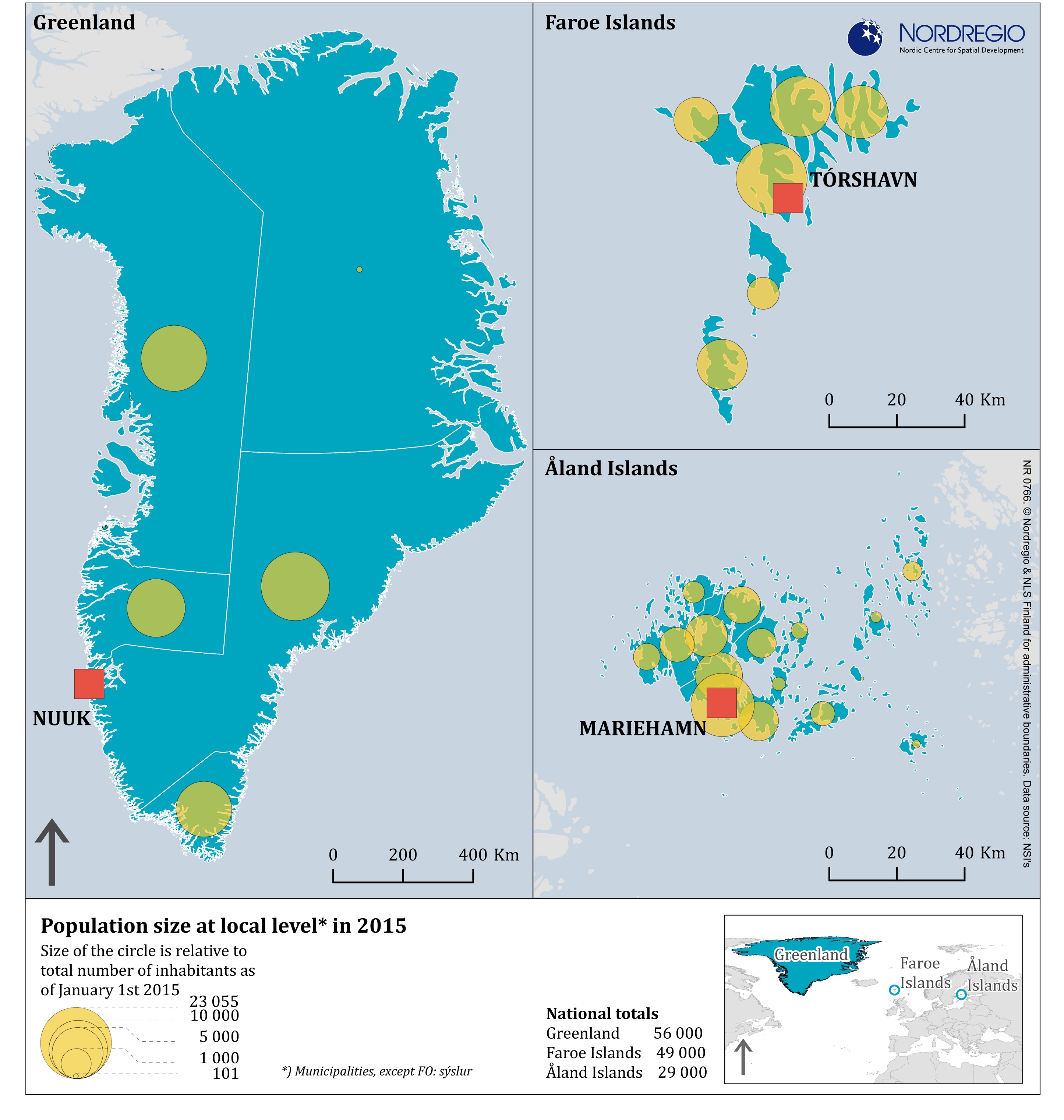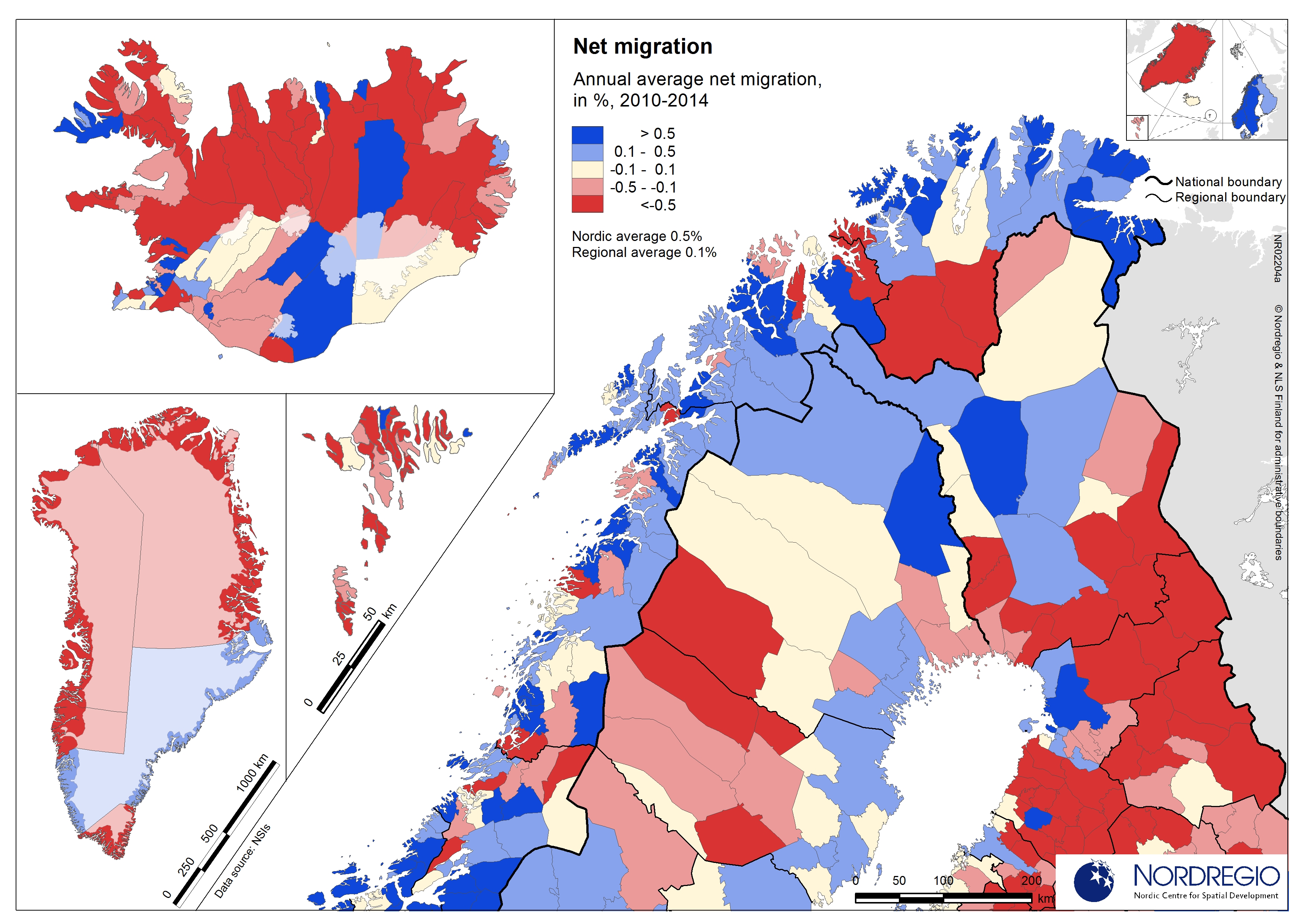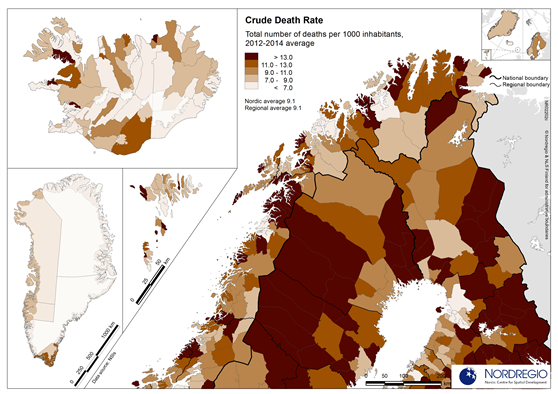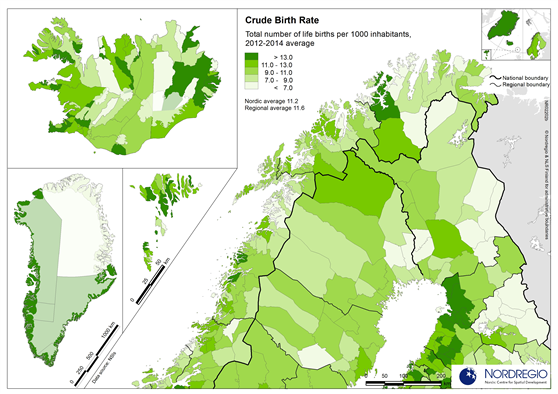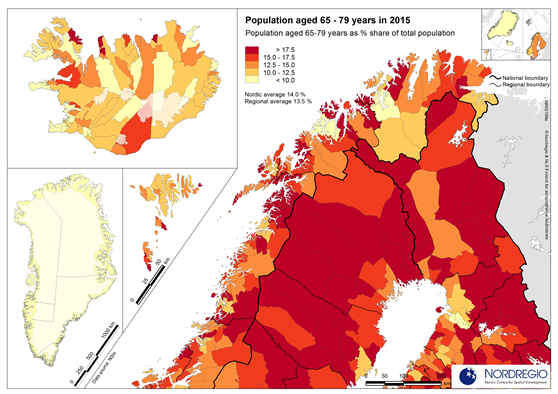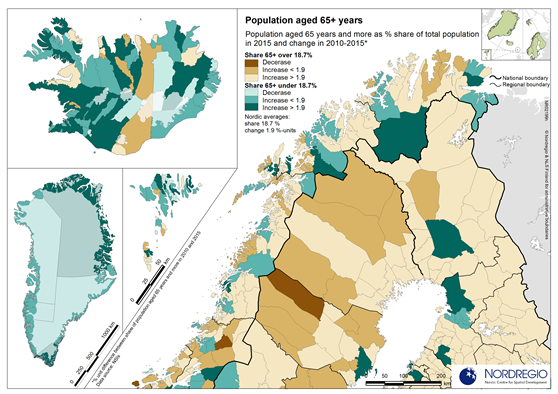49 Maps
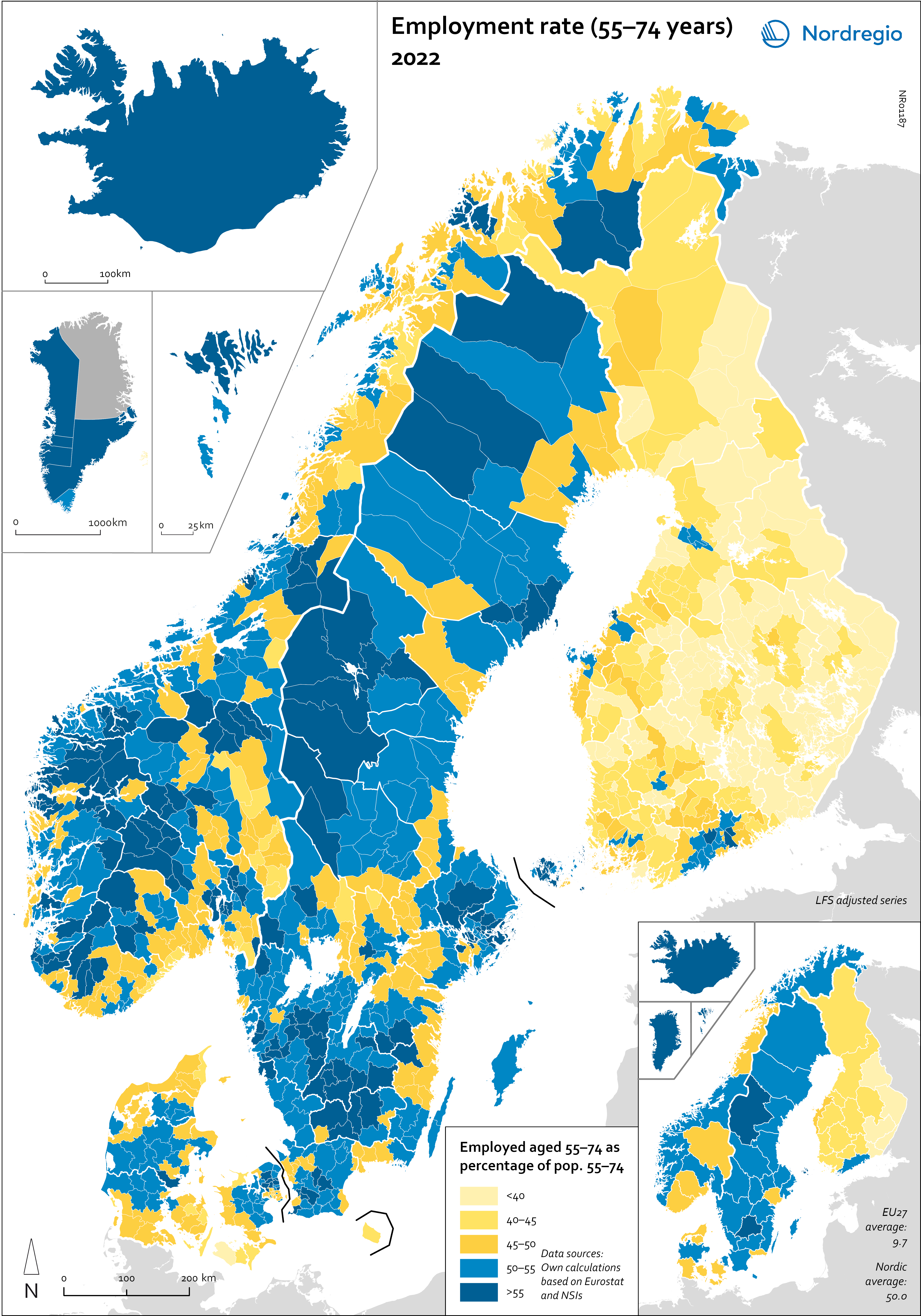
Employment rate (55-74 years) 2022
This map shows the employment rate for the age group 55-74 years in the Nordic municipalities (big map) and regions (small map) in November 2022. Employment rate refers to the share of population in a particular age group that is in employment (LFS definition), in this map it is measured for the age group 55-74 years. Older adults (55+) were less affected by the pandemic. In general, this age group has a stronger attachment to the labour market, and a higher proportion work in occupations where remote work was possible. For quite some time, the Nordic Region has boasted a higher employment rate among older adult workers compared to the rest of Europe, although this gap has narrowed somewhat in recent years. In 2022, 75.5% of the Nordic population aged 55–64 were employed, whereas the EU average stood at 62.3%, representing a difference of 13 percentage points. In 2012, however, this difference was 21 percentage points, and in 2002, it was 29. The map shows variation between the Nordic countries, with Finland exhibiting a lower employment rate for this age group. The highest rates were observed in the Faroe Islands (62%), Greenland (61%), Åland (56%), and the Swedish regions of Jämtland-Härjedalen (55%) and Jönköping (54%). The Labour Force Survey (LFS) is the official source for labour market statistics and the only source that is comparable across countries. The data comes from a standardised survey that is conducted in the same way in all EU countries, as well as in many non-EU countries, including in Norway, Iceland and the Faroe Islands. The LFS is the main source for the map, however since it is not possible to break down at a municipal level, register data has been made to create estimates at a municipal level.
2025 April
- Labour force
- Nordic Region
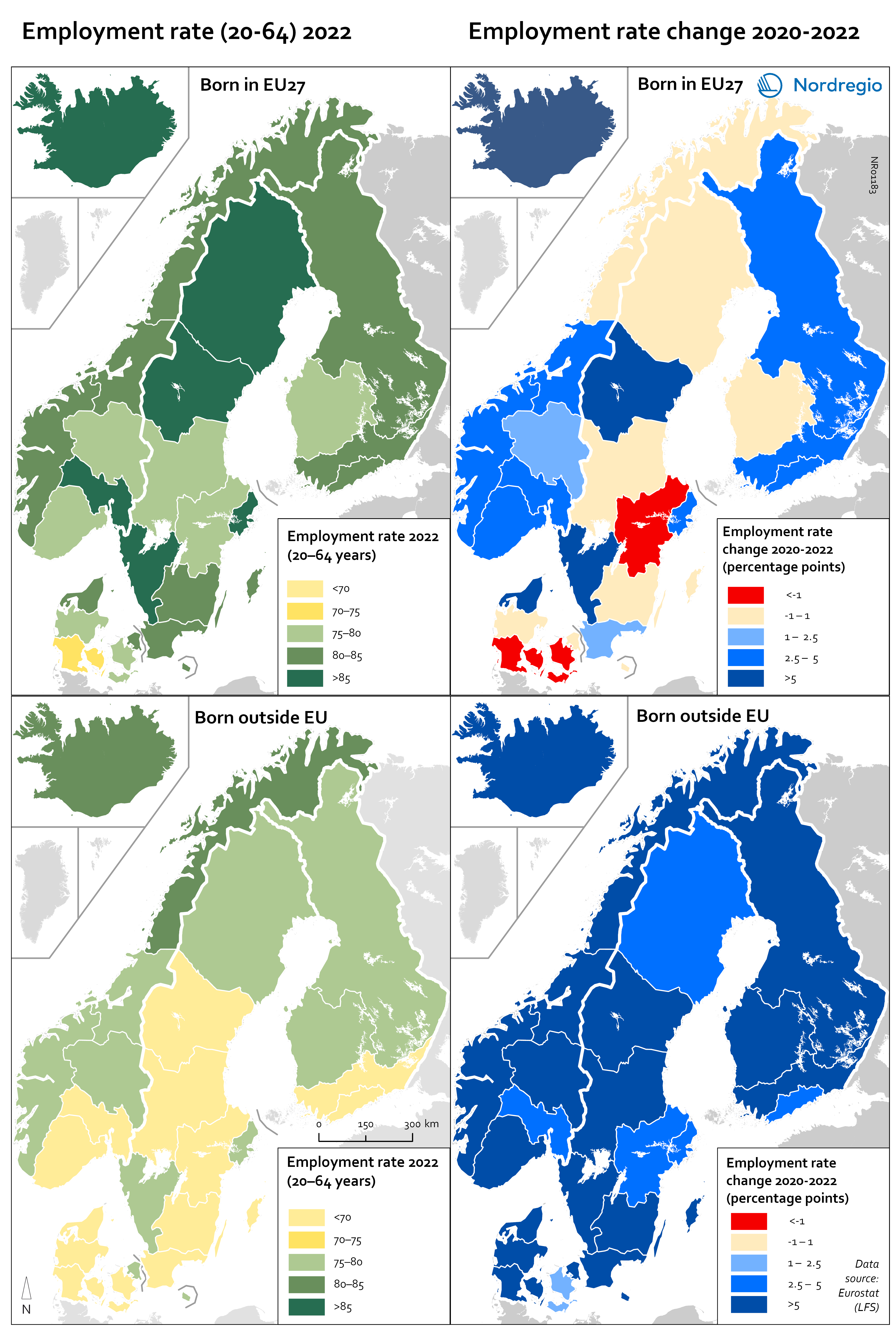
Employment rate 2022 and Employment rate change 2020-2022 among foreign-born
These maps shows the employment rate in 2022 for those born in a EU country (top left) and those born outside of the EU (bottom left), as well as the change in employment rate between 2020 and 2022 for those born in the EU (upper right) and outside the EU (lower right). The data is displayed at NUTS 2 level and comes from the labour force survey (LFS). The category ‘foreign-born’ is quite heterogeneous and consists of everything from labour migrants to refugees – two groups who face quite different conditions and have different connections to the labour market. The employment rate for people born in another EU country – a group that includes a large proportion of labour migrants – has been on par with the employment rate for native-born people for a long time. As can be seen in the top-left figure in the map, in 2022 all NUTS2 regions except Southern Denmark had an employment rate of 75% or more for this group. The highest employment rate was observed in the Swedish NUTS2 regions of Middle Norrland, Stockholm and Western Sweden, followed by Oslo in Norway and Iceland. The employment rate for people born outside of the EU (a group that largely consists of refugees) has been lower for a long time than that of native-born people and those born in the EU. While the employment rate for people born in non-EU countries is still lower than for natives (a 15 percentage point difference (pp) in Sweden, 11 pp in Norway, 7 pp in Denmark and Finland, and 2 pp in Iceland), this gap has been closing in the last couple of years since the pandemic. Between 2020 and 2022, the employment rate for those born outside of the EU rose almost eight percentage points in Denmark…
2025 April
- Labour force
- Nordic Region
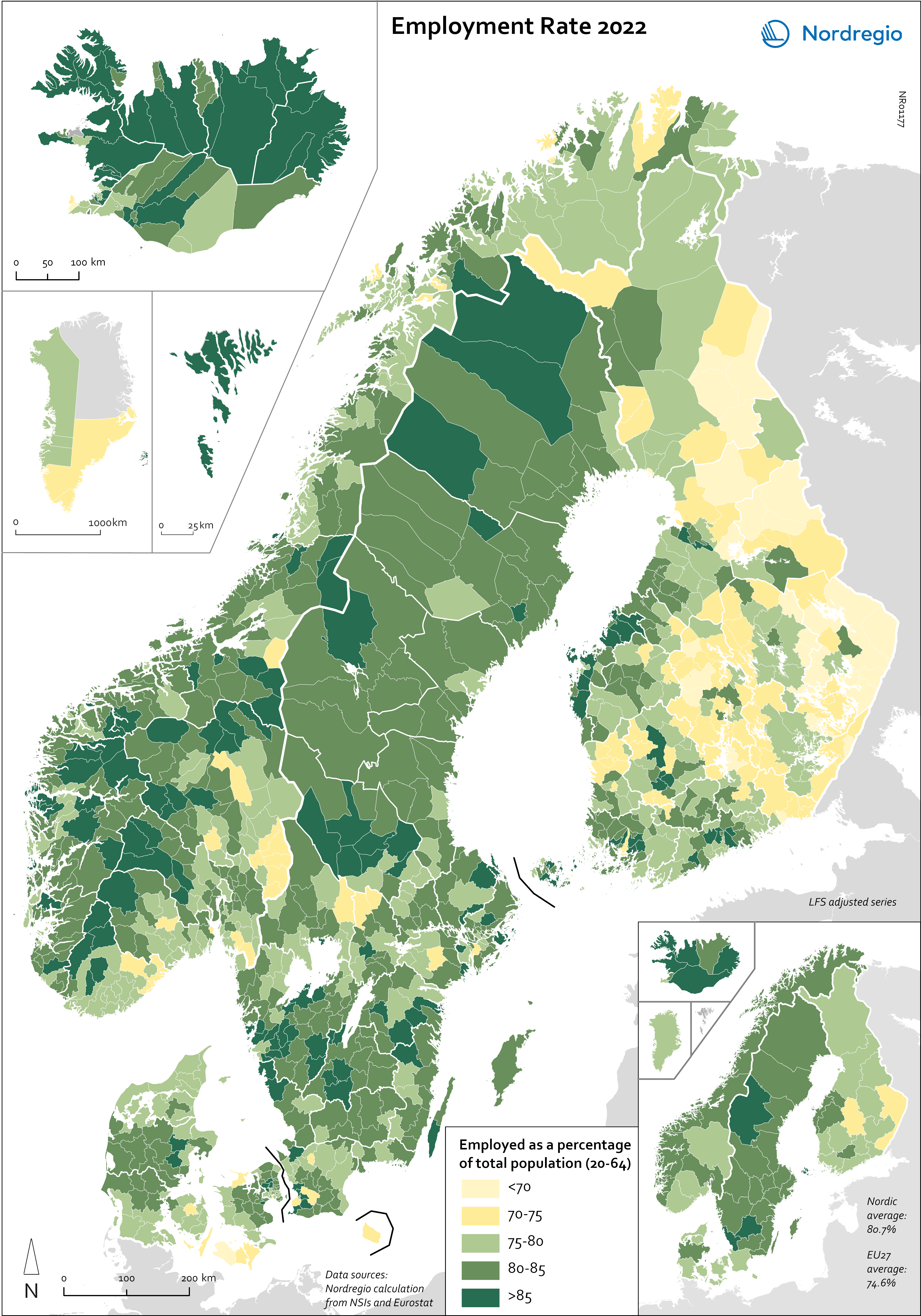
Employment rate 2022
This map shows the employment rate for Nordic municipalities (big map) and regions (small map) in 2022 (measured in November). Employment rate refers to the share of population in a particular age group that is in employment (LFS definition), in this map it is measured for the age group 20-64 years. At a national level, all of the Nordic countries have employment rates higher than the EU average (74.6%). The highest rates were in the Faroe Islands (93%), Åland (86%) and Iceland (83%), followed by Sweden (82.2%), Denmark (80.1%), Norway (80.9%), Finland (78.4%) and Greenland (75%). Of the EU countries, only the Netherlands (82.9%) had a higher employment rate than Sweden in 2022. As the map shows, most of the regions and municipalities had employment rates above 75% (the green areas on the map) in 2022, meaning that three-quarters of people aged 20–64 were working. In addition to the Faroe Islands, Iceland and Åland, the Swedish regions of Jämtland-Härjedalen, Halland and Jönköping also had employment rates of more than 85%. The only regions with employment rates under 75% were the Finnish regions of North and Southern Karelia and KeskiSuomi. On a municipal level, the highest employment rates were found in rural municipalities, mainly in Iceland and the Faroe Islands, as well as some municipalities in Österbotten in Finland (such as Pedersöe and Korsholm). Of the intermediate municipalities (between urban and rural), the highest employment rates were in the Swedish municipalities Habo (Jönköping), Hammarö (Värmland), Nykvarn (Stockholm), Gällivare (Norrbotten), Kungsbacka (Halland), Svedala (Skåne) and Mosfellsbær (Höfuðborgarsvæðið) in Iceland. Of the urban municipalities, the employment rate was highest in Garðabær and Kópavogur in the Capital Region of Iceland, Tyresö and Täby in the Stockholm region, Partille in Västra Götaland in Sweden, and Bærum and Rælingen in Viken in Norway. The lowest employment…
2025 April
- Labour force
- Nordic Region

New urban-rural typology of Nordic countries
A map portrays a new urban-rural typology based on the grid-level data. New Nordic urban-rural typology is a grid-based classification of areas developed by the Nordic Thematic groups 2021-2024 to enable more accurate cross-Nordic statistical comparisons. The seven classes are defined based on population density, proximity measures and land cover parameters. Read more about the typology here . Inner urban area is the most densely populated part of the urban core. Urban cores are clustered cells summing up to at least 15 000 inhabitants, and these are divided into Inner and Outer urban areas based on density criterion (population density and building floor space). Outer urban area is the least densely populated part of the urban core. Urban core areas are clustered cells with at least 15 000 inhabitants, and these are divided into Inner and Outer urban areas based on density criterions (population density and building floorspace). Peri-urban area is the intermediate zone between urban core and the rural. It is based on generalized travel-time estimates from the edges of outer urban areas (6 min travel-time zones) and smaller urban settlement (4,5 min travel-time zones). Local centers in rural areas are population centers located outside urban areas, small towns and large parish villages where population is between 5000-14999 inhabitants. Rural areas close to urban areas have a rural character that are functionally connected and close to urban areas. In average this means 20-30 of minutes’ drive time from the edge of outer urban area. This class overwrites the area classes ‘Rural heartland’ and ‘Sparsely populated rural areas’. Rural heartland. Rural areas with intensive land use, with a relatively dense population and a diverse economic structure at the local level. Most of the agricultural land is in this class. Sparsely populated rural areas. Sparsely populated areas with dispersed small settlements that are located at a distance from each other.…
2023 January
- Administrative and functional divisions
- Nordic Region
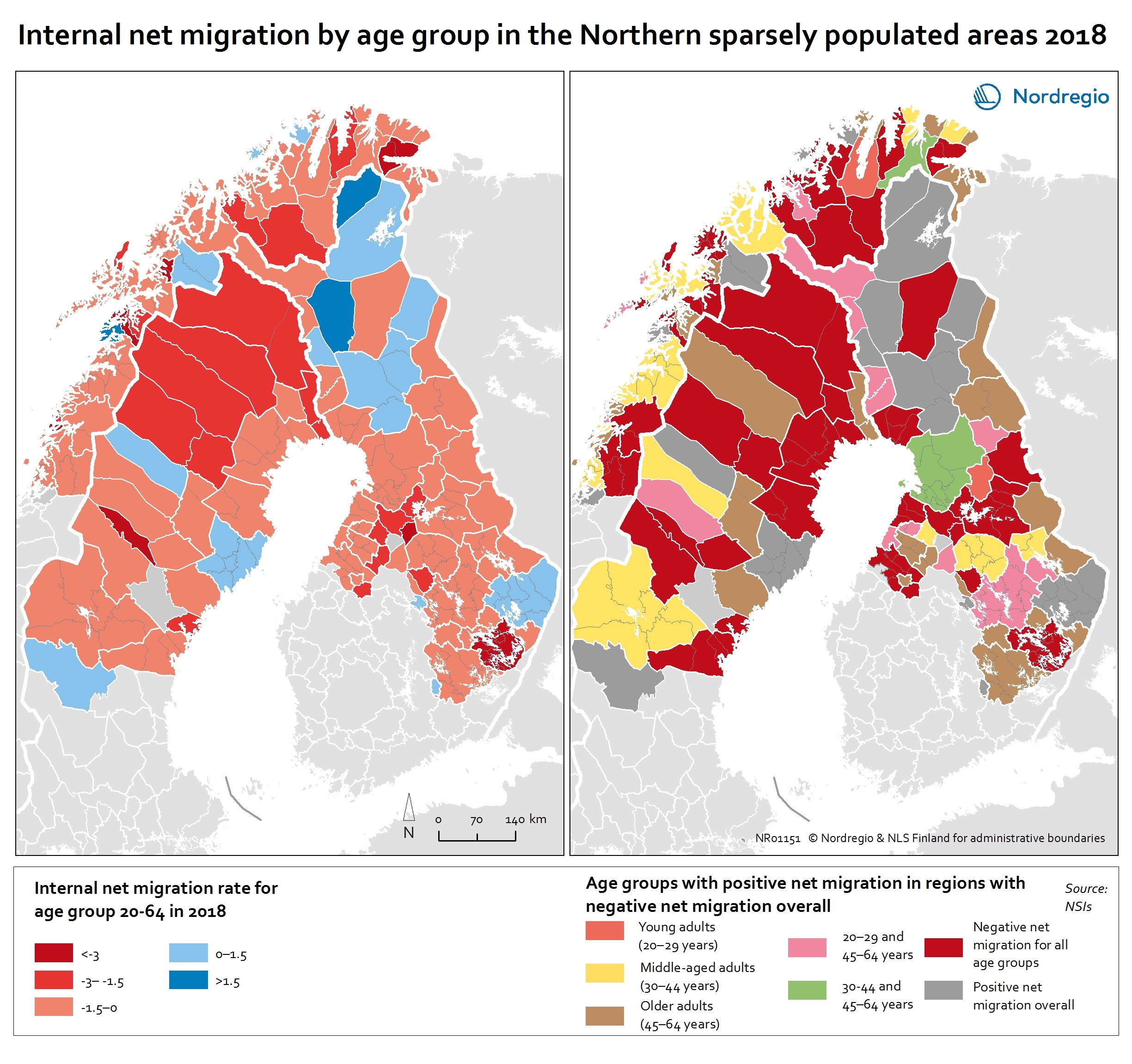
Internal net migration by age group in the Northern sparsely populated areas 2018
This map shows the internal net migration rate in 2018 (left map) and net migration by age group (right map) in local labour market areas of the Northern sparsely populated areas in 2018 The map on left shows the internal net migration rate in the NSPAs in 2018. Although many regions experienced negative net migration, this was not the case for all segments of the population. The map on the right of shows the age groups in which more people moved in than moved out, despite these regions having negative net migration overall. The red colours on the map on the left indicates a net out-migration, while the blue colours indicate a positive net migration. In the map on the right, the red colours indicate net out-migration for all age groups and the grey positive net migration overall. The other colours indicate age groups with a positive net migration (while having negative net migration overall). Inward and outward migration are slightly different in the local labour market areas (LLMAs) compared to the independent labour markets. Among the LLMAs, Rovaniemi is the only one that has positive net migration in all age groups. This positive development may be due to the number of governmental offices, the strength of the tourism industry and the presence of two universities. On the contrary, 18 local labour market areas– four in Sweden, nine in Norway and five in Finland – have negative net migration in all age groups. Out-migration of young adults is seen in most of LLMAs, the exceptions being Umeå, Målsev, Joensuu and Oulu. The inflows of young adults in these regions reflect the presence of the universities in Umeå, Joensuu and Oulu and the army bases in Målselv. Despite this positive inflow, most of these LLMAs are unable to retain adults in…
2020 February
- Demography
- Labour force
- Migration
- NSPA and North Atlantic

Early school leavers in 2014 by NUTS 2 regions
Persons with at most lower secondary education as share of total population aged 18-24 The map indicates variations within the Nordic countries with the lowest rates of early school leaving found in Swedish regions. In six of the eight Swedish NUTS 2 regions (riksområden) early school leavers make up less than seven percent of the population aged 18-24 years. Hovedstaden in Denmark is the only other Nordic region with a similar rate. In Finland (suuralue/storområde) and Norway (landsdel), variations between the NUTS 2 regions are bigger than in Sweden and Denmark. In the northernmost Finnish region, Pohjois- ja Itä-Suomi (North & East Finland), early school leavers make up a small portion of the population aged 18-24 years, below both the EU average (11.1%) and the two southernmost Finnish NUTS 2 regions. In the Faroe Islands, Iceland, Northern Norway, and, in particular, Greenland, the percentage of the population aged 18-24 years with lower-secondary school as their highest level of education is well above the EU average. With respect to gender, the balance is fairly even in northern Sweden and northern Norway. All other countries and regions included in the map show patterns consistent with the EU average, with males making up a larger portion of the early school leaving population.
2016 October
- Labour force
- NSPA and North Atlantic

